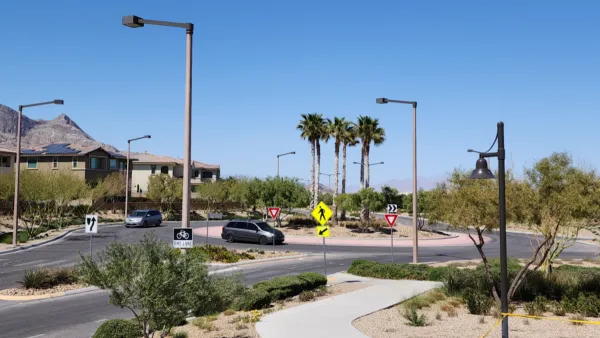Is a new luxury 6,721 square-foot home located in a gated community on the far outskirts of Las Vegas truly “the new face of efficiency"? Kaid Benfield elaborates on how the LEED certification system can be so easily gamed.
The new LEED-Platinum state-of-the-art home built by Blue Heron Homes in Henderson, Nevada occupies twice as much land, and is three times the size, of the average new-home in a US metro area. Not only that, but it is 1.2 miles to the nearest transit stop, and scores a meager 38 out of 100 for walkability. And yet, it has earned the the highest level of LEED certification. Despite acknowledging the beauty and wonder of its architectural elements including "extensive 'water features'” and "17,261 square feet of 'outdoor living space'", Benfield points out that something is not quite right with this picture.
He explains that "[t]he Seven Hills development [where the so-called "New American Home” is located] wouldn’t come close to qualifying for a certification under LEED for Neighborhood Development, which takes location and neighborhood design into account as well as building technology." And, though he commends LEED for “put[ting] green buildings on the map and institutionaliz[ing] building performance measures shown to reduce resource consumption and pollution” he also critiques the many “warts in this system” -- from “being insufficiently demanding of its applicants” to “becom[ing] pro forma, more about earning points than achieving actual environmental performance.”
He concludes, "Why should a building qualify for the highest, platinum rating – signifying the greenest of all green buildings – if it is completely dependent on long automobile trips that will collectively emit more carbon than the building’s efficient heating and cooling systems will save? Maybe ten years ago, the green building movement was so new that it would have been counterproductive to have high standards. But we should be better than that now."
FULL STORY: As good and important as it is, LEED can be so embarrassing

National Parks Layoffs Will Cause Communities to Lose Billions
Thousands of essential park workers were laid off this week, just before the busy spring break season.

Retro-silient?: America’s First “Eco-burb,” The Woodlands Turns 50
A master-planned community north of Houston offers lessons on green infrastructure and resilient design, but falls short of its founder’s lofty affordability and walkability goals.

Delivering for America Plan Will Downgrade Mail Service in at Least 49.5 Percent of Zip Codes
Republican and Democrat lawmakers criticize the plan for its disproportionate negative impact on rural communities.

Test News Post 1
This is a summary

Test News Headline 46
Test for the image on the front page.

Balancing Bombs and Butterflies: How the National Guard Protects a Rare Species
The National Guard at Fort Indiantown Gap uses GIS technology and land management strategies to balance military training with conservation efforts, ensuring the survival of the rare eastern regal fritillary butterfly.
Urban Design for Planners 1: Software Tools
This six-course series explores essential urban design concepts using open source software and equips planners with the tools they need to participate fully in the urban design process.
Planning for Universal Design
Learn the tools for implementing Universal Design in planning regulations.
EMC Planning Group, Inc.
Planetizen
Planetizen
Mpact (formerly Rail~Volution)
Great Falls Development Authority, Inc.
HUDs Office of Policy Development and Research
NYU Wagner Graduate School of Public Service




























